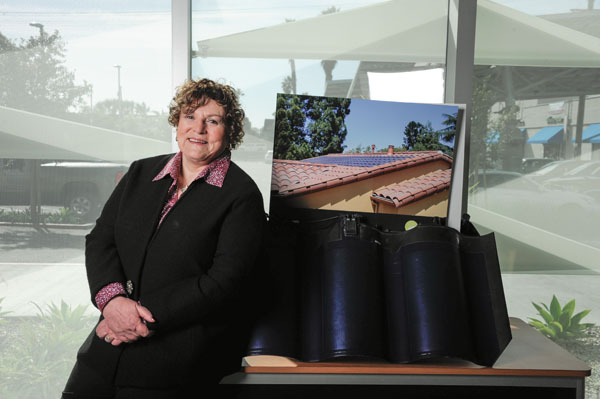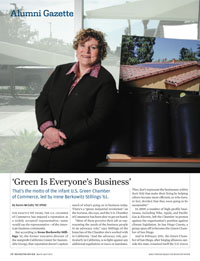Alumni Gazette
 GREEN LEADER: Stillings, the new president of the U.S. Green Chamber of Commerce, founded in 2011, is an experienced and effective
institution builder as well as an energy industry veteran, colleagues say. (Photo: Denis Poroy/AP Images for Rochester Review)
GREEN LEADER: Stillings, the new president of the U.S. Green Chamber of Commerce, founded in 2011, is an experienced and effective
institution builder as well as an energy industry veteran, colleagues say. (Photo: Denis Poroy/AP Images for Rochester Review)For exactly 101 years, the U.S. Chamber of Commerce has enjoyed a reputation as a widely accepted representative—some would say the representative—of the American business community.
But according to Irene Berkowitz Stillings ’61, the former executive director of the nonprofit California Center for Sustainable Energy, that reputation doesn’t capture much of what’s going on in business today. There’s a “green industrial revolution” on the horizon, she says, and the U.S. Chamber of Commerce has been slow to get on board.
“Most of them perceive their job as representing the needs of the business people in an advocacy role,” says Stillings of the branches of the Chamber she’s worked with in California. “And the advocacy role, particularly in California, is to fight against any additional regulations or taxes or mandates. They don’t represent the businesses within their fold that make their living by helping others become more efficient, or who have, in fact, decided that they were going to be sustainable.”
In 2009, a number of high-profile businesses, including Nike, Apple, and Pacific Gas & Electric, left the Chamber in protest against the organization’s position against climate legislation. In San Diego County, a group spun off to become the Green Chamber of San Diego. And in February 2011, the Green Chamber of San Diego, after forging alliances outside the state, renamed itself the U.S. Green Chamber of Commerce, launching its campaign to go national.
Leading that charge is Stillings, who several people associated with the Green Chamber say is uniquely suited for the task. In 2002, she left the corporate world to become the executive director of a small nonprofit called the San Diego Regional Energy Office. In 2006, when then Gov. Arnold Schwarzenegger signed into law the Global Warming Solutions Act—a bill establishing targets to reduce greenhouse gas emissions throughout California and a host of regulations to compel businesses, municipalities, and residents to meet them—Stillings seized on the opportunity to develop the office, which had supported the legislation, into a resource to help institutions comply with the new rules. In a few short years, the seven-person outfit, renamed the California Center for Sustainable Energy, had grown more than tenfold, offering courses, workshops, consulting, and other services to businesses, municipalities, and residents.
David Steel, CEO of the Green Chamber, says he “couldn’t be happier” to have Stillings at the helm of the infant organization.
“She took an organization that was very small, that nobody had heard of, and created something very powerful,” he said of her work at the center.
Gail Welch, the senior manager of sustainability at Qualcomm, a telecommunications firm that worked extensively with the center and now with the Green Chamber, notes that Stillings “knows how to engage people to bring about action.”
“She has a reputation for making things happen,” Welch says.
As for going national, Stillings says, “I think that the concept is ready to take off. Various kinds of green business organizations are popping up all over the country. The movement is very fragmented. And our purpose is to find a way to bring it together.”
Her commitment to environmentalism has been long-standing. “I remember reading Rachel Carson’s Silent Spring as that came out,” she says of the classic book, published in 1962, that many credit with helping launch the modern environmental movement. “I remember being horrified.”
Today, she’s equally clear about what motivates her. “I have nine grandchildren.”
So far, the Green Chamber has established branches in Texas and Florida and launched an initiative called the “100 Cities for Change” challenge to sell its mission and drum up membership. Stillings says the organization will focus on providing resources and networking opportunities to help small- and medium-sized businesses develop sustainable practices.
“They’re the hardest people to convince that they should take action,” says Stillings. “And it’s for good reasons. A lot of the things that are going to make a business efficient and sustainable take some time and take some money.” The goal of the Green Chamber, Stillings says, is to help business owners weigh financial, health, and environmental benefits in their decision-making processes.
Anyone who’s observed Stillings’s career over decades may recognize a pattern. In 1975, she got her first job in the energy industry as an assistant in customer service at New York State Electric & Gas. As a utility, it faced no competition. But Stillings drew the company’s attention to costs it hadn’t recognized: the time and money spent responding to customer complaints to the New York State Public Service Commission. Stillings collected and read customer comments. “We put on the back of the bill a place where they could write things. And it had been there before I came, but nobody ever looked at it,” she says. She used the comments as a springboard for a bimonthly report to management called “The Voice of the Customer,” which became a launching pad for new customer service initiatives.
By 1984, she’d been named an assistant vice president and by 1990, a vice president. Shortly after that, she retired—for the first time. She took on some private consulting projects and, her children grown and her friends retiring elsewhere, picked up with her husband, Tom, and moved to San Diego, the home of many of her clients, in 1999.
Rob Wilder, CEO of Wildershares, creator of a clean energy index, says she’s kept a bit of the East Coast with her. And that’s good, he thinks, for San Diego and for the organizations that she’s run.
“She’s got an East Coast persona,” says Wilder, a native of Baltimore. “We’re not as laid back as Californians. We tend to get to the point.”

